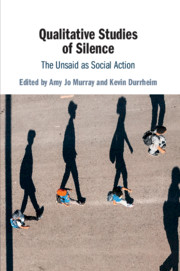Book contents
- Qualitative Studies of Silence
- Qualitative Studies of Silence
- Copyright page
- Dedication
- Contents
- Figures
- Contributors
- Acknowledgments
- Introduction: A Turn to Silence
- 1 Literal and Metaphorical Silences in Rhetoric: Examples from the Celebration of the 1974 Revolution in the Portuguese Parliament
- 2 Seeing Silenced Agendas in Medical Interaction: A Conversation Analytic Case Study
- 3 Listening to the Sound of Silence: Methodological Reflections on Studying the Unsaid
- 4 Social Silences: Conducting Ethnographic Research on Racism in the Americas
- 5 Intimate Silences and Inequality: Noticing the Unsaid through Triangulation
- 6 Silence in the Court: Moral Exclusion at the Intersection of Disability, Race, Sexuality, and Methodology
- 7 Silencing Self and Other through Autobiographical Narratives
- 8 Gendering the Unsaid and the Unsayable
- 9 The Language Ideology of Silence and Silencing in Public Discourse
- 10 Propaganda by Omission: The Case of Topical Silence
- 11 Silencing Whistleblowers
- 12 Between Sound and Silence: The Inaudible and the Unsayable in the History of the First World War
- 13 Affect and the Unsaid: Silences, Impasses, and Testimonies to Trauma
- 14 The Unsaid and the Unheard
- 15 Conclusion: Topographies of the Said and Unsaid
- Index
- References
Introduction: A Turn to Silence
Published online by Cambridge University Press: 30 June 2019
- Qualitative Studies of Silence
- Qualitative Studies of Silence
- Copyright page
- Dedication
- Contents
- Figures
- Contributors
- Acknowledgments
- Introduction: A Turn to Silence
- 1 Literal and Metaphorical Silences in Rhetoric: Examples from the Celebration of the 1974 Revolution in the Portuguese Parliament
- 2 Seeing Silenced Agendas in Medical Interaction: A Conversation Analytic Case Study
- 3 Listening to the Sound of Silence: Methodological Reflections on Studying the Unsaid
- 4 Social Silences: Conducting Ethnographic Research on Racism in the Americas
- 5 Intimate Silences and Inequality: Noticing the Unsaid through Triangulation
- 6 Silence in the Court: Moral Exclusion at the Intersection of Disability, Race, Sexuality, and Methodology
- 7 Silencing Self and Other through Autobiographical Narratives
- 8 Gendering the Unsaid and the Unsayable
- 9 The Language Ideology of Silence and Silencing in Public Discourse
- 10 Propaganda by Omission: The Case of Topical Silence
- 11 Silencing Whistleblowers
- 12 Between Sound and Silence: The Inaudible and the Unsayable in the History of the First World War
- 13 Affect and the Unsaid: Silences, Impasses, and Testimonies to Trauma
- 14 The Unsaid and the Unheard
- 15 Conclusion: Topographies of the Said and Unsaid
- Index
- References
Summary
We open the book by showing – briefly, by a consideration of the South African Truth and Reconciliation Commission – how our social worlds are structured around silences and absences; and how even the process of unsilencing can lay down new absences. We explain why qualitative research in the social and human sciences has often neglected studying silences as it focused on the presences in talk, discourse, and interaction. We then provide a quick roadmap of the silence literature that has begun to gain momentum as part of what we cal, “a turn to silence.” Finally, we outline the perspectives and objectives of this book, arguing that qualitative studies are well suited to explore the unsaid, which we conceptualized as a slippery and multilayered form of social action. The chapter provides an overview of the collection and introduces the two broad questions answered by each of its contributors, namely: (1) “What is unsaid?” – focusing attention on methods, practices, and perspectives for identifying absence, and (2) “What is the unsaid doing (here)?” – focusing attention on the ideological significance of absence.
Keywords
- Type
- Chapter
- Information
- Qualitative Studies of SilenceThe Unsaid as Social Action, pp. 1 - 20Publisher: Cambridge University PressPrint publication year: 2019
References
- 7
- Cited by

